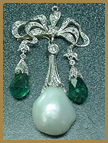 The period which constitutes the segment of the Edwardian era of fine jewelry creation was 1880 through 1915.
The period which constitutes the segment of the Edwardian era of fine jewelry creation was 1880 through 1915.
During the 1880’s, King Edward and his bride, the Danish Princess Alexandra, were often hosting lavish parties, hunts and masquerade balls. In doing so, they were setting standards of dress for British society. These standards spread throughout Europe and the Americas. Much jewelry of this period had design elements that set them apart from other jewelry, and were regularly worn by this privileged class of debutantes.
The Edwardian period was distinct from the Victorian era of fine jewelry making in that the Edwardian pieces were more elegant and far less conservative than their Victorian era counterparts. Fancy blue diamonds colored by traces of elemental boron from Africa. Green diamonds colored by elemental uranium from South America. Pink diamonds derived from stressed diamond crystals of varied stages of crystallization development. Yellow diamonds colored by nitrogen particles were also arriving from South America and Africa. These all found their way into the elegantly fashioned brooches, rings and earrings designed in this period.
Platinum began being used in the early 1880’s for fine jewelry as sources for platinum were being made more available. The use of gas to melt platinum in jewelry manufacture also enabled the much higher melting point of platinum to yield to the jeweler’s torch. There were also bountiful supplies of diamonds from South Africa, sapphires and rubies from the Far East, and demantoid garnet, alexandrite and fine amethyst from Russia. Jade and pearls too were available as England’s influence was far and wide during this time.
Edwardian jewelry has an unrivaled splendor and hand crafted quality unequaled to the present day. This Edwardian era jewelry is sought after by our collector market internationally.
Specific fine jewelry manufactures of note from this period were: Tiffany & Co., Cartier, Van Cleef and Arpels, Marcus & Co., Raymond Yard, David Webb and Georg Jensen.
